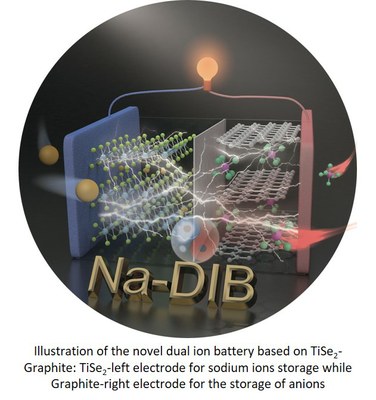A novel dual ion battery based on TiSe2-Graphite: a bright future
Climate change is already affecting the whole world, with extreme weather conditions such as drought, heat waves, heavy rains, floods and landslides becoming more frequent, including in Europe. Other consequences of the rapidly changing climate include rising sea levels, ocean acidification and loss of biodiversity. With the European climate law (Green Deal), the EU is committed to achieving carbon neutrality by 2050. These climate disruptions are largely linked to fossil fuel sources used by humans. To replace them, new sources of renewable energy with a low carbon footprint have been developed. They have the advantage of being available in unlimited quantities. Their use constitutes a means of meeting growing energy needs and societal requirements for sustainable development, but involves numerous technical constraints. Unfortunately, renewable energy sources are generally discontinuous or even intermittent. Energy storage, such as, for example, by Li-ion batteries (LIB), then constitutes an important lock in the strategy for exploiting these energies, in particular within the framework of the integration of these devices into an isolated or global network.
The LIB currently available can no longer meet the requirements, especially with regard to the high energy requirements of modern systems.
 Dual-ion sodium (Na-DIB) batteries with Na ion storage anode and anion storage graphite cathode have emerging potential compared to Li ion batteries for the next generation of storage systems. electrochemical energy due to their high voltage, high energy density, low cost and environmental friendliness. Unlike conventional "rocking chair" sodium ion batteries with insertion of cations only, anions (eg PF6-, AlCl4-, ClO4-, TFSI-, FTFSI- and FSI-) and cations (Na+) can be simultaneously stored and released at the anode and Na-DIB cathode electrodes, during charge and discharge, respectively. This unique configuration of simultaneous insertion of cations and anions can thus lead to faster electrode kinetics.
Dual-ion sodium (Na-DIB) batteries with Na ion storage anode and anion storage graphite cathode have emerging potential compared to Li ion batteries for the next generation of storage systems. electrochemical energy due to their high voltage, high energy density, low cost and environmental friendliness. Unlike conventional "rocking chair" sodium ion batteries with insertion of cations only, anions (eg PF6-, AlCl4-, ClO4-, TFSI-, FTFSI- and FSI-) and cations (Na+) can be simultaneously stored and released at the anode and Na-DIB cathode electrodes, during charge and discharge, respectively. This unique configuration of simultaneous insertion of cations and anions can thus lead to faster electrode kinetics.
To date, several classes of anode materials (eg, soft and hard carbons, alloys, metal oxides, polyanionic compounds) have been explored for Na-DIB. However, these materials suffer from serious problems which limit performance in terms of power and stability. Recently, Professor Bao-Lian Su, director of Inorganic Materials Chemistry Laboratory, and his doctoral student, Mr. Runtian Zheng, together with Professor Jie Shu from Ningbo University, China, reported, in the prestigious journal "Angwente Chemie Internartional Edition", that titanium diselenide (TiSe2) is a potential anodic material for Na-DIB due to its large spacing between layers allowing rapid diffusion and abundant active sites for accommodation Na ions. Compared to other Na-DIBs, the new Na-DIB battery based on TiSe2-graphite significantly improves the insertion kinetics of Na ions with superior cycle stability. Testing the electrochemical performance of a prototype TiSe2-graphite Na-DIB battery clearly shows that Na ions are inserted into TiSe2 while PF6- are synchronously inserted into graphite during the charging process. A reversible capacity of 81 mAh / g at a current density of 100 mA / g with a capacity retention of 83.52% after 200 cycles of use. The new TiSe2-graphite Na-DIB battery also has the advantages of lower voltage variation, attenuated volume expansion and much better cycle stability compared to other Na-DIBs.
This work shows the great potential of the new Na-DIB battery for the future generation of large-scale stationary electricity storage systems and provides new ideas for the development of dual-ion sodium batteries. It also highlights the UNamur expertise in the topic.
Article information
A Novel TiSe2-Graphite Dual Ion Battery: Fast Na-Ion Insertion and Excellent Stability | Runtian Zheng, Haoxiang Yu, Xikun Zhang, Yang Ding, Maoting Xia, Kangzhe Cao, Jie Shu*, Alexendru Vlad, Bao-Lian Su* | Angewandte Chemie International Editio, Volume 60, Issue34, Pages 18430-18437
DOI: 10.1002/anie.202105439
Contact: Prof Bao-Lian Su - bao-lian.su@unamur.be
This article is also available in French...
| Share this news | ||||||||||
 |
 |
|||||||||











